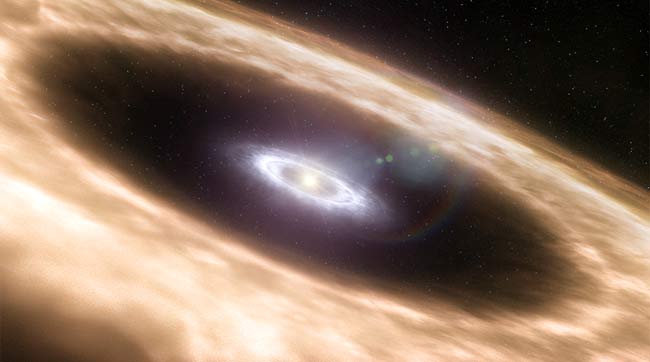Most Alien Solar Systems Are 'Flatter Than Pancakes'

Our solar system is shaped like a thin-crust pizza, with most of the planets traveling around the sun close to the same plane, and it's apparently not alone. A new study suggests the majority of alien planetary systems are much like ours, "flatter than pancakes," scientists say.
UCLA astronomers looked at data from NASA's planet-hunting Kepler space telescope and found that more than 85 percent of alien planets have inclinations of less than 3 degrees. This means they orbit around a star near the same axis as other planets in their system.
"The best mental image for the geometry of planetary systems is somewhere between a crepe and a pancake," UCLA professor Jean-Luc Margot explained in a statement today (Oct. 15).
"I made pancakes this weekend to verify our analogy. I measured a mean thickness of 7.3 mm (a little under one-fourth of an inch) and a mean radius of 65 mm (about 2.5 inches). This corresponds to inclinations of six degrees," Margot said. "So most planetary systems are flatter than pancakes, by about a factor of two."
Seven of eight planets in our own solar system have inclinations of less than 3 degrees. The exception, Mercury, is inclined by about 7 degrees in relation to Earth's ecliptic. At the edge of the solar system, the dwarf planet Pluto has an inclination of about 17 degrees, but it is no longer considered a full-fledged planet.
"Our solar system may be common compared to other planetary systems in this regard," study researcher Julia Fang, a UCLA graduate student, said in a statement. "Perhaps we're not that special."
Since its March 2009 launch, Kepler has detected more than 2,300 possible alien worlds, but recent statistical studies suggest our galaxy likely harbors more than 100 billion exoplanets.
Get the Space.com Newsletter
Breaking space news, the latest updates on rocket launches, skywatching events and more!
The UCLA research has been submitted to the Astrophysical Journal. Researchers presented the study at the annual meeting of the Division for Planetary Sciences of the American Astronomical Society in Reno, Nevada.
Follow SPACE.com on Twitter @Spacedotcom. We're also on Facebook and Google+.

Join our Space Forums to keep talking space on the latest missions, night sky and more! And if you have a news tip, correction or comment, let us know at: community@space.com.

Space.com is the premier source of space exploration, innovation and astronomy news, chronicling (and celebrating) humanity's ongoing expansion across the final frontier. Originally founded in 1999, Space.com is, and always has been, the passion of writers and editors who are space fans and also trained journalists. Our current news team consists of Editor-in-Chief Tariq Malik; Editor Hanneke Weitering, Senior Space Writer Mike Wall; Senior Writer Meghan Bartels; Senior Writer Chelsea Gohd, Senior Writer Tereza Pultarova and Staff Writer Alexander Cox, focusing on e-commerce. Senior Producer Steve Spaleta oversees our space videos, with Diana Whitcroft as our Social Media Editor.









